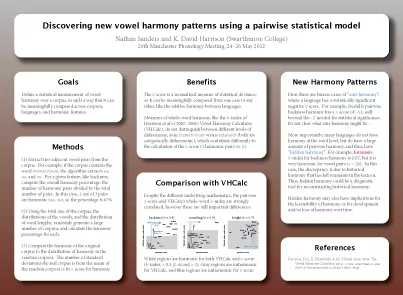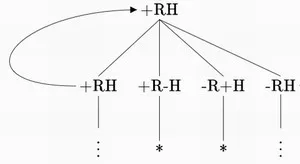Computational Phonology

Discovering New Vowel Harmony Patterns Using a Pairwise Statistical Model, Nathan Sanders and K. David Harrison. Download PDF
The goal of this project is to define a basic statistical measure of vowel harmony over an arbitrary corpus, such that this measure can be used to meaningfully compare the relative harmony between any languages, corpora, or phonological features. For example, we might want to know whether Finnish is more harmonic for backness than Hungarian is, or whether Tuvan is more harmonic for backness than for roundness, or whether Turkish is more harmonic for backness in literary writing than in academic writing. With such a measure of vowel harmony applied to the appropriate temporally spaced corpora, we could even determine the quantitative trajectory of a language’s harmony over time: when and how fast it increased or decreased.
Poster Handout

Graphic by E. Thomforde.
I am particularly interested in a set of complex, emergent patterns known under the umbrella term vowel harmony. These patterns show an immense range of variation, undergo dynamic change, and exhibit many properties of self-organizing systems. They pose interesting challenges for Linguistic theory and for modeling more general cognitive functions such as pattern recognition and statistical learning. I study these patterns (1) empirically (in the field in Siberia), (2) by devising formal models, and (3) by building simulations of artificial speech communities.
In collaboration with my students, I've developed a web tool to detect harmony patterns in languages.



